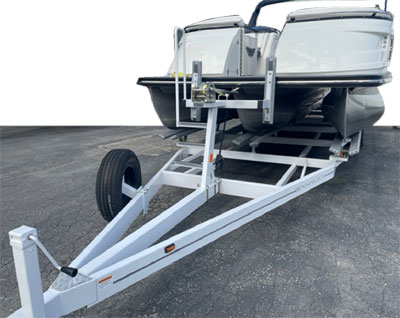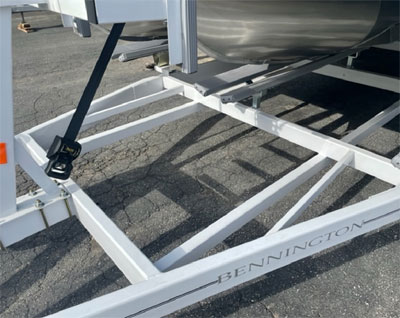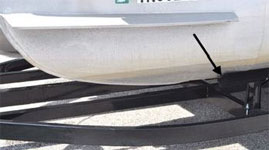 |
|||
| The way the trailer fits in the back is more critical. Most of the weight in modern pontoons is in the stern. The captain’s helm, gas tanks, the engine, etc. The back of the tubes should not extend much more than a foot beyond the back of the trailer. The images to the left show a good fit. The image on the far right shows a boat with 3+’ of overhang. This will affect the balance on the trailer and result in too little tongue weight. In the picture you can see how the front of the trailer seems tilted up. | |||
 |
|||
| Our trailers are fully adjustable. Older boats were 8’ wide and are usually on 72” centers. Newer boats (after about 2008) are often 8’6” wide and are usually adjusted to 77” centers. But there is no exact dimension for all brands. The rule of thumb is 72” and 77” but for a perfect fit you should measure the center to center distance. It’s just a ten minute job to move the carpeted bunks, but its easier to do with power tools at the manufacturer or dealership. | |||
 |
|||
| It’s possible to use some trailers for various length pontoons. By sliding the winch stand forward or back you have about 2’ of adjustability. The same trailer frame can fit a 18-21’ or 22’-24’ boat. You must be careful when moving the winch stand back to make sure you maintain proper tongue weight. | |||
 |
|||
| The strength of the winch stand is in the center of the support arms. The front of the pontoon should rest as closely to the center as possible. These front arms take considerable force when you come in fast. This is called power loading. On a good ramp you drive your boat all the way onto the trailer. If you don’t throttle back you can actually damage the winch stand and the front of the boat. Newer boats have larger diameter pontoons. Some trailer manufacturers still use winch stands designed for 23” diameter pontoons on 25” or 27” diameter pontoons. Make sure the winch stand is the proper height for your pontoons. Most manufacturers won’t offer you any warranty relief if you damage their stand. In our opinion companies that use short stands on big pontoons have a design defect, but again it will be your problem, not the trailer builder. | |||
| Below is an example of a poorly fitted trailer. | |||
 |
|||
| Unfortunately it's one we sold. The customer told us he had a 23’ pontoon and we set up the trailer to fit. Unfortunately when he got the boat on the trailer he discovered his pontoon was a 20’ pontoon. Fortunately he was only a couple hours away and we were able to swap out trailers, but this is an example of why getting the proper information allows us to help you achieve a perfect fit. | |||
| The pontoon
below is the deluxe Bennington Q series on a custom 6” frame trailer.
The owner didn’t scrimp on this package. The trailer is extremely well
made and braced, BUT the trailer is 8’-10’ too long for the boat.
It’s a triple axle so weight distribution probably isn’t a problem, but
it seems that the selling dealer or the customer might have noticed all
the trailer sticking out the front. When traveling with a 27’ long
pontoon an extra 10’ sticking out the front just seems wrong. The trailer has a Bennington sticker on it, to match the boat. Bennington did not make the trailer the dealer added the sticker. If the owner needs warranty or parts when he calls Bennington he’ll find out they didn’t make the trailer. Hopefully the trailer manufacturers name will be on the original bill of sale. I’m not a “fan” of white trailers, they show dirt easily and sooner or later you’ll see small rust spots, but it does match the white fiberglass front of the pontoon and looks gorgeous at least when its new. |
|||
 |
 |
||
 Here’s another trailer that’s too long, it’s for a Quest 14’ pontoon that’s closer to 12’ long. The boat is on a trailer designed to fit a 14’-16’ pontoon. The customer probably ordered a 14’ trailer only to discover his boat was shorter. On a small boat like this having a bit of extra trailer in the front can make launching easier. Because the boat is lightweight, balance won’t be a problem. |
|||
Securing the Pontoon to the Trailer | |||
| Very few pontoons were actually
attached to the trailer. A high majority were just “sitting on” the
carpeted bunks although in most cases they were attached to the front
loading winch. In an emergency stop, the front loading winch will do nothing to prevent the pontoon from sliding forward. In theory the winch stand will probably prevent the boat from sliding into the tow vehicle, but some pontoons weight 4000+ lbs. There is no guarantee any winch stand can withstand that force moving forward. When traveling pontoons SHOULD be securely attached to the trailer. Both with the front loading winch, pulled down into the Anti Bucking position and with rear straps holding the boat onto the trailer on the rear. | |||
 Every bunk trailer we’ve sold in the past thirty years has an Anti Bucking loop in the center of the winch stand. Loosen the strap on the winch, thread it down through the loop and back up into the tow eye or first cross channel on the pontoon. This helps secure the front of the boat to the trailer and also pulls the front of the boat down so it won’t “buck”. | |||
 All of our pontoon trailers have stern tie down eyelets. Most pontoons have stern tie down eyes. We offer the common tie down ratchet straps (near our cost) on our website and also bolt on tie down ratchet straps as options. Having the pontoon attached to the trailer in the rear will keep it from sliding off in an incline or sudden start. An additional benefit especially on larger heavier pontoons is that they will prevent the boat from “bouncing” on the trailer. | |||
 Set of four individual ratchet straps $24 |
 (Pair of two) bolt onto the rear tie down ratchet straps $85 (pair) | ||
 | |||
For Information Call (877)294-3395 or (574)294-3386 | |||
 Trailers for Pontoons
Trailers for Pontoons
For all your Pontoon Trailer Needs!
(800)877-1544 - (574)294-3386
(800)877-1544 - (574)294-3386
 Choosing
the right size trailer to fit your pontoon boat is a fairly simple
matter but it’s amazing how often people, including marine industry
professionals, get it wrong. Logic would dictate that if you have a
20’ pontoon you’d want a 20’ trailer. 24’ pontoon, 24’ trailer, etc.
But you must be careful.
Choosing
the right size trailer to fit your pontoon boat is a fairly simple
matter but it’s amazing how often people, including marine industry
professionals, get it wrong. Logic would dictate that if you have a
20’ pontoon you’d want a 20’ trailer. 24’ pontoon, 24’ trailer, etc.
But you must be careful. 